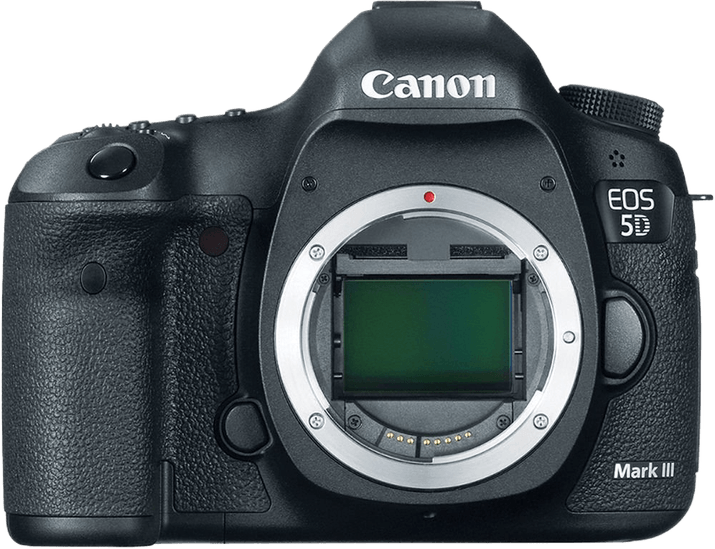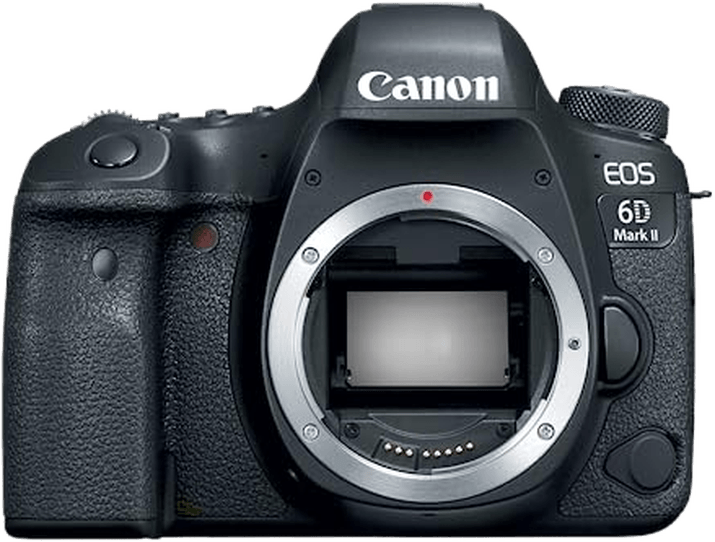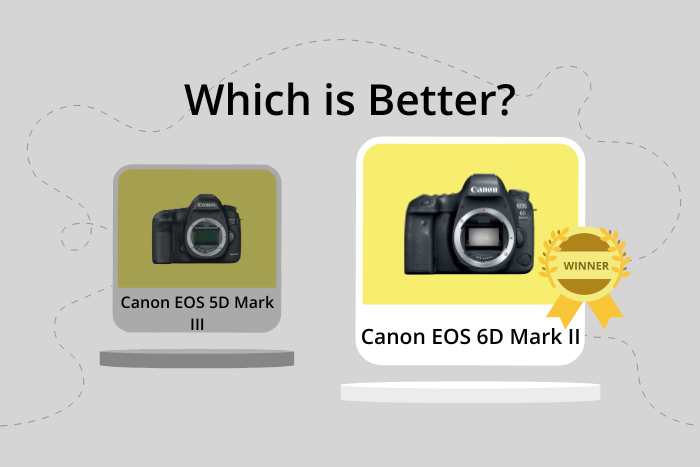Canon EOS 5D Mark III vs EOS 6D Mark II Comparison
Canon EOS 5D Mark III

Canon EOS 6D Mark II

The Canon EOS 6D Mark II takes the lead with a score of 71/100, while the Canon EOS 5D Mark III trails behind with a score of 65/100. Both cameras are DSLRs and were launched at different times – the 5D Mark III in 2012 and the 6D Mark II in 2017. They share similarities in size, with the 6D Mark II being slightly smaller and significantly lighter, weighing only 1.00lbs compared to the 5D Mark III at 2.09lbs.
The 6D Mark II excels with its more recent release and lower launch price of $2000, compared to the 5D Mark III’s $3499. The 5D Mark III, however, has a higher weight, which can be a preference for some photographers looking for a more substantial feel. Ultimately, the 6D Mark II offers better value and a more compact design, while the 5D Mark III may appeal to those who prefer a heavier camera.
Canon EOS 5D Mark III vs EOS 6D Mark II Overview and Optics
The Canon EOS 6D Mark II edges out the Canon EOS 5D Mark III in the optics department with a score of 69/100 compared to 67/100. Both cameras share several specifications, including a full-frame CMOS sensor, Canon EF lens mount, and a lack of image stabilization.
The 6D Mark II’s higher score is due to its superior megapixel count and shooting speed. With 26.2 megapixels, it captures more detail than the 5D Mark III, which has 22.3 megapixels. Additionally, the 6D Mark II has a faster shooting speed at 6.5 frames per second compared to the 5D Mark III’s 6 frames per second. The 6D Mark II also boasts a better processor, the DIGIC 7, which contributes to its improved image quality and speed.
The 5D Mark III, however, has its own advantages. It features a DIGIC 5+ processor, which, while not as advanced as the DIGIC 7, still delivers reliable performance. The 5D Mark III’s DXOMARK sensor score of 81 is only slightly lower than the 6D Mark II’s 85, indicating that the difference in image quality between the two cameras may not be drastic.
Taking these factors into account, the Canon EOS 6D Mark II is the better camera in terms of optics. Its higher megapixel count, faster shooting speed, and more advanced processor give it an edge over the Canon EOS 5D Mark III. While the 5D Mark III remains a competent camera, the 6D Mark II’s improvements make it the superior choice for those prioritizing optical performance.
Canon EOS 5D Mark III vs EOS 6D Mark II Video Performance
The Canon EOS 6D Mark II takes the lead in video capabilities with a score of 57/100, while the Canon EOS 5D Mark III trails closely behind with a score of 56/100. Both cameras feature Full HD video resolution with maximum dimensions of 1920 x 1080. However, the similarities in their video specifications end here.
The Canon EOS 5D Mark III outperforms the 6D Mark II in terms of maximum video frame rate, offering 60fps compared to the 6D Mark II’s 30fps. This higher frame rate allows for smoother video playback and is especially beneficial when capturing fast-moving subjects or creating slow-motion footage.
On the other hand, the Canon EOS 6D Mark II boasts a built-in time-lapse functionality, which the 5D Mark III lacks. This feature enables users to easily capture time-lapse videos without the need for additional equipment or software, making it a more convenient option for those interested in this type of videography.
While the Canon EOS 5D Mark III offers a higher video frame rate, the Canon EOS 6D Mark II’s built-in time-lapse functionality makes it the winner in terms of video capabilities. The 6D Mark II’s additional feature provides an advantage for users looking to create time-lapse videos without extra hassle. However, for those prioritizing smooth playback and slow-motion footage, the 5D Mark III’s higher frame rate might be more appealing. Ultimately, the choice between these two cameras for video capabilities will depend on the user’s specific needs and preferences.
Canon EOS 5D Mark III vs EOS 6D Mark II Features and Benefits
The Canon EOS 6D Mark II emerges as the winner in the features category with a score of 83/100, significantly outperforming the Canon EOS 5D Mark III, which scored 59/100. Both cameras share similarities, such as a 3-inch screen size and a screen resolution of 1,040,000 dots. However, the 6D Mark II surpasses the 5D Mark III in various aspects, making it the superior choice in terms of features.
The 6D Mark II offers a touchscreen, enabling users to navigate menus and settings with ease, while the 5D Mark III lacks this functionality. Additionally, the 6D Mark II provides a flip screen, allowing users to capture images from different angles and perspectives more conveniently. In terms of connectivity, the 6D Mark II comes equipped with GPS, Wi-Fi, and Bluetooth capabilities, ensuring seamless sharing and transfer of images, whereas the 5D Mark III does not include these features.
The 5D Mark III does not offer any advantages over the 6D Mark II in the features category. As a result, the 6D Mark II is the clear winner in this comparison, providing users with a more versatile and user-friendly experience. The inclusion of a touchscreen, flip screen, and multiple connectivity options make the 6D Mark II the better choice for photographers seeking advanced functionality and ease of use in their camera.
Canon EOS 5D Mark III vs EOS 6D Mark II Storage and Battery
The Canon EOS 5D Mark III triumphs over the Canon EOS 6D Mark II in the storage and battery category, scoring 76 points against 45. Both cameras share common specifications, including the use of SD/SDHC/SDXC memory cards and the absence of USB charging capabilities. However, the 5D Mark III offers two memory card slots and accepts Compact Flash and UDMA cards, providing more storage options than the 6D Mark II, which has only one memory card slot.
In terms of battery life, the 6D Mark II outperforms the 5D Mark III with 1200 shots per charge compared to 950 shots, using the LP-E6N battery type. Despite this advantage, the overall superiority in storage options and compatibility makes the 5D Mark III a more versatile choice for photographers.
Canon EOS 5D Mark III vs EOS 6D Mark II Alternatives
Still unsure whether to buy a Canon 6D Mark II vs 5D Mark III? You might be interested in our recent articles on the best Canon cameras for beginners or Sony vs Canon mirrorless cameras next. If you prefer to continue checking out camera specs, try these popular comparisons:

